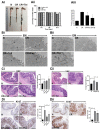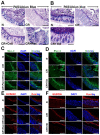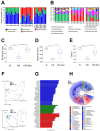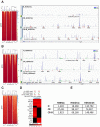Dietary Interventions Ameliorate Infectious Colitis by Restoring the Microbiome and Promoting Stem Cell Proliferation in Mice
- PMID: 35008767
- PMCID: PMC8745185
- DOI: 10.3390/ijms23010339
Dietary Interventions Ameliorate Infectious Colitis by Restoring the Microbiome and Promoting Stem Cell Proliferation in Mice
Abstract
Decreases in short-chain-fatty-acids (SCFAs) are linked to inflammatory bowel disease (IBD). Yet, the mechanisms through which SCFAs promote wound healing, orchestrated by intestinal stem cells, are poorly understood. We discovered that, in mice with Citrobacter rodentium (CR)-induced infectious colitis, treatment with Pectin and Tributyrin diets reduced the severity of colitis by restoring Firmicutes and Bacteroidetes and by increasing mucus production. RNA-seq in young adult mouse colon (YAMC) cells identified higher expression of Lgr4, Lgr6, DCLK1, Muc2, and SIGGIR after Butyrate treatment. Lineage tracing in CR-infected Lgr5-EGFP-IRES-CreERT2/ROSA26-LacZ (Lgr5-R) mice also revealed an expansion of LacZ-labeled Lgr5(+) stem cells in the colons of both Pectin and Tributyrin-treated mice compared to control. Interestingly, gut microbiota was required for Pectin but not Tributyrin-induced Lgr5(+) stem cell expansion. YAMC cells treated with sodium butyrate exhibited increased Lgr5 promoter reporter activity due to direct Butyrate binding with Lgr5 at -4.0 Kcal/mol, leading to thermal stabilization. Upon ChIP-seq, H3K4me3 increased near Lgr5 transcription start site that contained the consensus binding motif for a transcriptional activator of Lgr5 (SPIB). Thus, a multitude of effects on gut microbiome, differential gene expression, and/or expansion of Lgr5(+) stem cells seem to underlie amelioration of colitis following dietary intervention.
Keywords: Citrobacter rodentium; Pectin; Tributyrin; bacterial infection; colitis; dietary intervention; gut microbiome; intestinal stem cells; lgr5; short-chain-fatty-acids (SCFAs).
Conflict of interest statement
The authors declare no conflict of interest.
Figures







Similar articles
-
Removal of the cecum affects intestinal fermentation, enteric bacterial community structure, and acute colitis in mice.Gut Microbes. 2018;9(3):218-235. doi: 10.1080/19490976.2017.1408763. Epub 2018 Mar 13. Gut Microbes. 2018. PMID: 29227180 Free PMC article.
-
Pectins that Structurally Differ in the Distribution of Methyl-Esters Attenuate Citrobacter rodentium-Induced Colitis.Mol Nutr Food Res. 2021 Oct;65(19):e2100346. doi: 10.1002/mnfr.202100346. Epub 2021 Aug 16. Mol Nutr Food Res. 2021. PMID: 34369649 Free PMC article.
-
λ-carrageenan exacerbates Citrobacter rodentium-induced infectious colitis in mice by targeting gut microbiota and intestinal barrier integrity.Pharmacol Res. 2021 Dec;174:105940. doi: 10.1016/j.phrs.2021.105940. Epub 2021 Oct 16. Pharmacol Res. 2021. PMID: 34666171
-
Ground flaxseed reverses protection of a reduced-fat diet against Citrobacter rodentium-induced colitis.Am J Physiol Gastrointest Liver Physiol. 2018 Nov 1;315(5):G788-G798. doi: 10.1152/ajpgi.00101.2018. Epub 2018 Aug 10. Am J Physiol Gastrointest Liver Physiol. 2018. PMID: 30095298
-
Overview of the Effect of Citrobacter rodentium Infection on Host Metabolism and the Microbiota.Methods Mol Biol. 2021;2291:399-418. doi: 10.1007/978-1-0716-1339-9_20. Methods Mol Biol. 2021. PMID: 33704766 Review.
Cited by
-
Health Benefits of Dietary Fiber for the Management of Inflammatory Bowel Disease.Biomedicines. 2022 May 26;10(6):1242. doi: 10.3390/biomedicines10061242. Biomedicines. 2022. PMID: 35740264 Free PMC article. Review.
-
A secreted sirtuin from Campylobacter jejuni contributes to neutrophil activation and intestinal inflammation during infection.Sci Adv. 2023 Aug 11;9(32):eade2693. doi: 10.1126/sciadv.ade2693. Epub 2023 Aug 11. Sci Adv. 2023. PMID: 37566649 Free PMC article.
-
Melatonin-related signaling pathways and their regulatory effects in aging organisms.Biogerontology. 2022 Oct;23(5):529-539. doi: 10.1007/s10522-022-09981-y. Epub 2022 Jul 27. Biogerontology. 2022. PMID: 35895186 Review.
-
SCFAs switch stem cell fate through HDAC inhibition to improve barrier integrity in 3D intestinal organoids from patients with obesity.iScience. 2023 Nov 23;26(12):108517. doi: 10.1016/j.isci.2023.108517. eCollection 2023 Dec 15. iScience. 2023. PMID: 38125020 Free PMC article.
-
View from the Biological Property: Insight into the Functional Diversity and Complexity of the Gut Mucus.Int J Mol Sci. 2023 Feb 20;24(4):4227. doi: 10.3390/ijms24044227. Int J Mol Sci. 2023. PMID: 36835646 Free PMC article. Review.
References
-
- Candela M., Perna F., Carnevali P., Vitali B., Ciati R., Gionchetti P., Rizzello F., Campieri M., Brigidi P. Interaction of probiotic Lactobacillus and Bifidobacterium strains with human intestinal epithelial cells: Adhesion properties, competition against enteropathogens and modulation of IL-8 production. Int. J. Food Microbiol. 2008;125:286–292. doi: 10.1016/j.ijfoodmicro.2008.04.012. - DOI - PubMed
MeSH terms
Substances
Grants and funding
LinkOut - more resources
Full Text Sources
Medical
Miscellaneous

